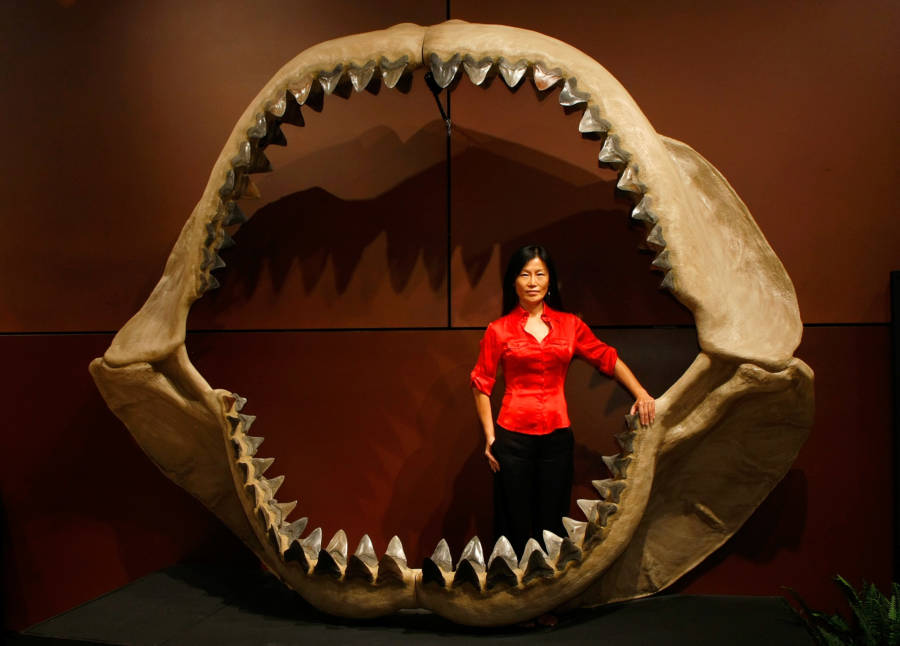For decades, scientists have been unsure how a creature as ferocious as this could have met its end. Now they have an idea.

Ethan Miller/Getty ImagesEnya Kim from the Natural History department at auctioneers Bonhams & Butterfields stands inside an authentic set of megalodon jaws comprised of about 180 teeth in Las Vegas on September 30, 2009.
If you thought Jaws was scary, be grateful that you weren’t alive 2 million years ago, back when the megalodon shark ruled Earth’s waters.
One of the most frightening predators in history, these 60-foot creatures dominated the ocean food chain for more than 20 million years. Then, despite their seven-inch mega-teeth, they vanished.
https://www.youtube.com/watch?v=J_1etrtDrYop
For decades, scientists have only been able to speculate on what knocked out history’s largest shark (three times the size of today’s great whites). Now, they think they finally know.
The last ice age is widely believed to have at least partially triggered a large extinction event on land (affecting creatures like ground sloths, saber-toothed cats, woolly mammoths). The dominant theory in the scientific community had been that the massive water creatures living around this same time were less affected by the ice age’s extreme temperature shift.
But new research from the University of Zurich shows that a previously unknown mass extinction had already changed the seas, killing off up to 55 percent of marine mammals, 43 percent of sea turtles, 35 percent of sea birds, and nine percent of sharks about 2 million years ago, before the ice age even took hold.
The nature of the extinction event is uncertain, but researchers suggest that it involved habitat loss due to shifting sea levels.
“It’s astonishing that an extinction event like this, among the biggest animals in the oceans, could go undetected until now,” study co-author Dr. John Griffin, told the ITV network. “It overturns the assumption that the oceans’ biodiversity was resistant to the environmental change in Earth’s recent history.”
Indeed, some scientists now believe that this mass marine extinction event wiped out the megalodon, as well as giant sea sloths, half of all sea turtle species, and many whales as well.
These deaths may have also helped trigger the land extinction associated with the ice age. Shifting sea levels along with a difference in marine prey likely caused new kinds of predators to emerge on land as coastal habitats changed.
The opening in the marine life food chain also paved the way for other creatures to develop, including polar bears and yellow-eyed penguins, which are now thought to be direct results of the newly discovered mass marine extinction.

VASILY MAXIMOV/AFP/Getty Images
Though this extinction event happened in the very distant past, the historic discovery comes with a warning for our future.
“This study shows that marine megafauna were far more vulnerable to global environmental changes in the recent geological past than had previously been assumed,” a statement on the study notes. “Nowadays, large marine species such as whales or seals are also highly vulnerable to human influences.”
The megalodon is long gone, but modern whales and turtles are following a frighteningly similar path to that of their predecessors.
And if history is indeed to repeat itself, the sixth mass extinction on land would come next.
After learning about the Megalodon extinction, check out the video that a few brave (or stupid) people took of a great white shark flailing in shallow water. Then, watch police warn unaware paddleboarders that they’re surrounded by great whites.





